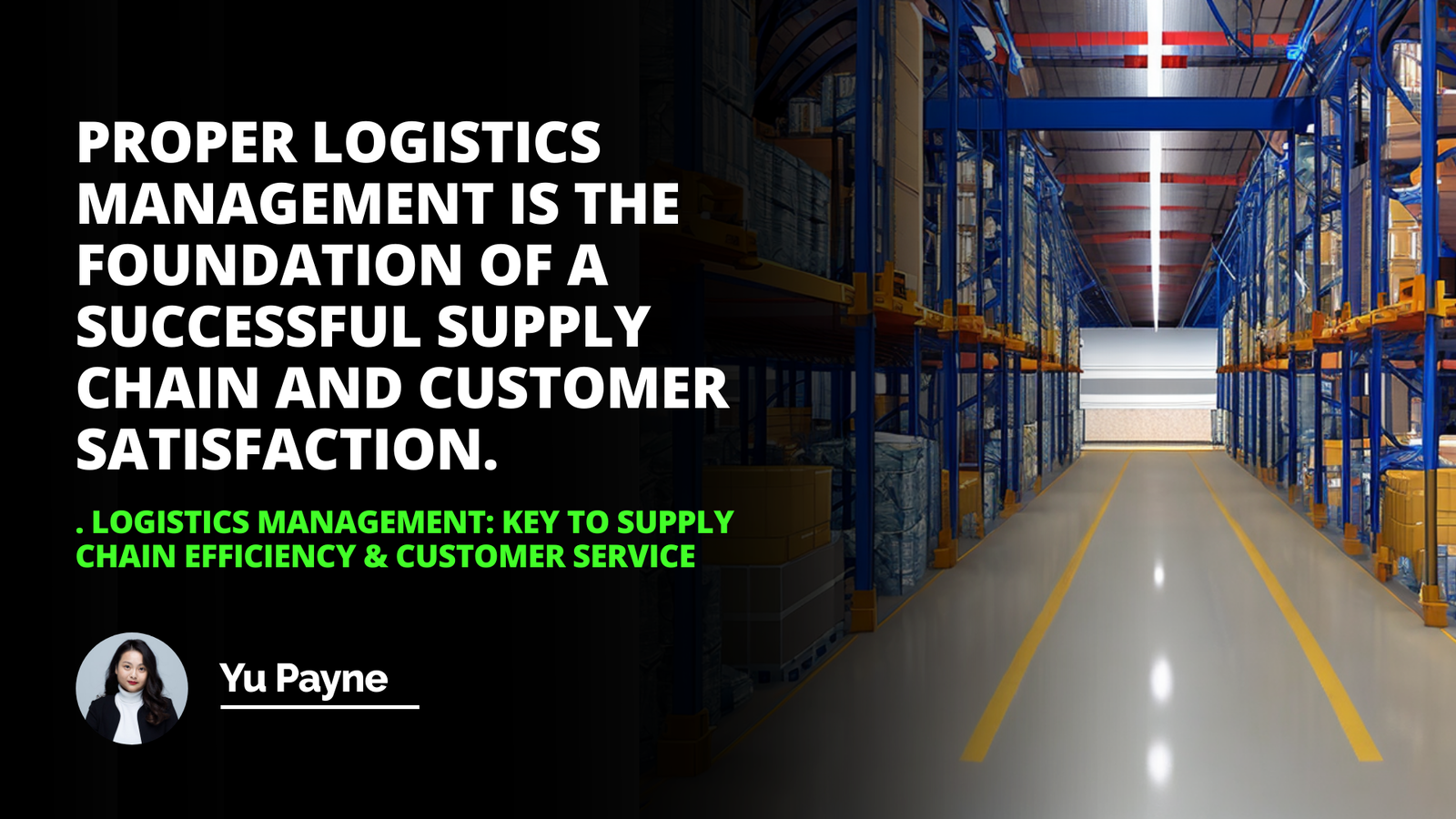
Warehouses: The Unsung Heroes of Supply Chain Management
Benefits of Warehouses for Material Storage
Types of Warehouses & Storage Solutions
Challenges & Considerations of Material Storage
An Exploration of Material Storage and Its Impact on Business Efficiency
Introduction
I still remember visiting my grandfather's small hardware store as a child. The front of the store was a bustling realm of customers and cash registers, but the back—oh, the back was a labyrinth of shelves stacked high with tools, nails, and bits of machinery I couldn't even name. As I wandered those aisles, I marveled at how everything had its place, each item waiting patiently for its turn to be of use. Little did I know, this was my first introduction to the concept of material storage and the vital role that warehouses play in our everyday lives.
Fast forward a few decades, and now I'm managing logistics for a mid-sized manufacturing company. The complexities of today's supply chain management make my grandfather's store look quaint by comparison. Yet, the fundamental need remains the same: efficiently storing and managing materials to ensure smooth operations. Warehouses have evolved dramatically, becoming high-tech hubs that are crucial to a company's success.
Effective Procurement Management Strategies For Supply Chain Success
Hierarchical Logistics Planning Framework To Optimize Supply Chain And Reduce Costs
In this piece, I'll delve into the benefits of warehouses for material storage, explore various types of warehouses and storage solutions, and discuss the challenges and considerations that come with managing material storage in the modern world.
The Benefits of Warehouses for Material Storage
When I first took over the logistics department, one of my biggest challenges was figuring out how to optimize our inventory management. Our products were scattered across multiple locations, leading to delays and confusion. Establishing a centralized warehouse was a game-changer.
Here are some of the key benefits we've experienced:
1- Improved Organization and Efficiency: By having a dedicated space for all materials, we've been able to categorize and label everything meticulously. This has significantly reduced the time spent searching for items.
2- Enhanced Security: Warehouses offer a controlled environment where access can be monitored. Knowing that our valuable materials are safe provides peace of mind. We invested in a security system with cameras and alarms, and we also implemented strict access protocols.
Maximizing Inbound Logistics: Benefits, Challenges & Strategies
Analyzing the Role of Drones in Streamlining Supply Chain Processes
3- Cost Reduction: Consolidating storage into a warehouse has helped us save on costs associated with renting multiple storage spaces. Moreover, bulk storage often leads to discounts from suppliers.
4- Better Customer Service: With quicker access to materials, we've been able to shorten our product delivery times. This has improved our relationships with clients and given us a competitive edge.
5- Risk Management: Warehouses protect materials from environmental hazards. For instance, we store certain sensitive components in <u>climate-controlled sections</u> to prevent damage.
I can't stress enough how inventory and management in a warehouse setting has streamlined our operations. The critical path method project management strategy we've adopted relies heavily on having materials available when needed, and our warehouse plays a pivotal role in that.
Types of Warehouses & Storage Solutions
Over the years, I've learned that not all warehouses are created equal. Depending on a company's needs, different types of warehouses and storage solutions can be employed.
Public Warehouses
These are facilities owned by third parties that offer storage space for rent. They are ideal for businesses that need flexible storage options without the investment of owning a warehouse. We initially used a public warehouse before we had the volume to justify our own space.
Private Warehouses
Owned and operated by individual companies, private warehouses offer complete control over storage practices. While the upfront costs are higher, they can be customized to fit specific needs. When we outgrew the public warehouse, we decided to build our own private facility.
Climate-Controlled Warehouses
For businesses dealing with perishable goods or sensitive materials, climate-controlled warehouses are essential. They maintain stable temperature and humidity levels, protecting products from spoilage or degradation. A friend in the pharmaceutical industry swears by these for storing medications.
Automated Storage and Retrieval Systems (AS/RS)
Incorporating cutting-edge technology, AS/RS uses robotics to store and retrieve items. This not only speeds up operations but also minimizes human error.
A warehouse may be unseen, yet its storage essential is the backbone of commerce.

Benefits of AS/RS:
Reduced labor costs
Increased accuracy
Enhanced safety
We recently integrated an AS/RS in our warehouse, and it's been fascinating to see robots zipping around, fetching items with precision.
Fulfillment Centers
These warehouses focus on order fulfillment for e-commerce businesses. They handle receiving, processing, and shipping orders directly to customers. With the rise of online shopping, fulfillment centers have become increasingly important.
Cross-Docking Facilities
In cross-docking, products are directly transferred from inbound to outbound transportation with minimal or no storage time. This method reduces storage costs and speeds up delivery times.
Advantages of Cross-Docking:
Decreased inventory holding costs
Improved product flow
Reduction in labor costs
Distribution Centers
While similar to warehouses, distribution centers are more dynamic, frequently moving products in and out. They're strategically located to optimize delivery routes. Aligning our company logistic strategies with efficient distribution centers has been vital for timely deliveries.
Supply and chain management often combines several of these warehouse types to create an efficient management chain supply system.
Challenges & Considerations of Material Storage
Despite the many benefits, material storage isn't without its challenges.
Space Constraints
One of the first issues we faced was running out of space. As our business grew, so did our need for storage. We had to decide whether to expand our current warehouse or build a new one.
Considerations:
Cost of expansion vs. new construction
Location logistics
Future growth projections
Inventory Management Complexity
Managing a large inventory is no small feat. Implementing an effective inventory mgmt system is crucial.
Solutions:
Inventory Management Software: We adopted a robust software system that tracks inventory levels in real time.
Regular Audits: Conducting periodic inventory counts helps ensure accuracy.
Staff Training: Educating employees on proper inventory practices minimizes errors.
Compliance and Regulations
Warehouses must adhere to various regulations, including safety standards and environmental laws.
Key Areas:
Occupational Safety and Health Administration (OSHA) guidelines
Fire codes
Hazardous material handling procedures
Failing to comply can result in hefty fines and jeopardize employee safety.
Technology Integration
Keeping up with technological advancements can be daunting. However, integrating new technology is essential for staying competitive.
Technologies to Consider:
Warehouse Management Systems (WMS)
Radio-Frequency Identification (RFID) Tags
Internet of Things (IoT) Devices
Supply Chain Disruptions
External factors, such as natural disasters or pandemics, can severely impact the supply chain management.
Mitigation Strategies:
Diversifying suppliers
Increasing safety stock levels
Developing contingency plans
I recall the challenges we faced during the recent global pandemic. Supply chain disruptions forced us to rethink our strategies and emphasize the importance of flexibility in our operations.
Embracing Modern Solutions
The landscape of material storage is continually evolving. New strategies and technologies are emerging to address the challenges businesses face.
Sustainable Warehousing
Environmental concerns are prompting companies to adopt greener practices.
Examples:
Installing solar panels on warehouse roofs
Implementing energy-efficient lighting
Utilizing eco-friendly packaging materials
Collaborative Logistics
Businesses are partnering to share warehouse space and distribution networks.
Benefits:
Cost savings
Reduced environmental impact
Improved efficiency
Advanced Analytics
Using data analytics helps optimize warehouse operations.
Applications:
Predicting inventory needs
Identifying bottlenecks
Enhancing customer satisfaction
Our company recently started using analytics to forecast demand more accurately, allowing us to adjust our inventory levels proactively.
The Human Element
While technology plays a significant role, the human element should not be overlooked.
Training and Development
Investing in employee training ensures that staff can effectively use new technologies and follow best practices.
Focus Areas:
Safety Protocols
Technology Use
Customer Service Skills
Safety Culture
Creating a culture that prioritizes safety reduces accidents and improves morale.
Strategies:
Regular safety meetings
Encouraging employee feedback
Recognizing and rewarding safe practices
I take pride in knowing that our warehouse has an excellent safety record, thanks to the efforts we've made to prioritize our team's well-being.
Conclusion
Looking back to those days in my grandfather's store, I realize that the essence of inventory and inventory management hasn't changed—it's all about having the right products in the right place at the right time. Warehouses may not be glamorous, but they are the backbone of commerce, ensuring that goods move efficiently from producers to consumers.
In today's fast-paced world, effective supply chain management is more critical than ever. By understanding the benefits, types, and challenges of material storage, businesses can make informed decisions that enhance their operations. Whether it's through adopting new technologies, embracing sustainable practices, or investing in employee development, the potential for improvement is vast.
A warehouse may be unseen, yet its storage essential is the backbone of commerce. As we continue to innovate and adapt, warehouses will remain integral to a successful management chain supply system. The key is to recognize their importance and continuously seek ways to optimize their function.
References
1- Chopra, S., & Meindl, P. (2016). Supply Chain Management: Strategy, Planning, and Operation (6th ed.). Pearson Education.
2- Richards, G. (2017). Warehouse Management: A Complete Guide to Improving Efficiency and Minimizing Costs in the Modern Warehouse (3rd ed.). Kogan Page Publishers.
3- Frazelle, E. (2016). World-Class Warehousing and Material Handling (2nd ed.). McGraw-Hill Education.
Frequently Asked Questions
What is an efficient system for managing material storage in a warehouse?
Efficiently managing material stored in a warehouse is paramount for any business. Warehouse management systems are an integral part of optimizing warehouse inventory and mobility and, in turn, reducing operational costs and increasing operational efficiencies. This article will explore the fundamentals of an efficient warehouse material storage management system.
A practical warehouse space layout, including racking and storage units, is the foundation of a well-managed system. The form should be designed considering the type and size of material being stored in the warehouse, in addition to the receiving and shipping needs of the business. Additionally, Investing in properly configured racking can help expand the storage area and facilitate quick and efficient material retrieval. Adopting an organized system for picking and putting away material and incorporating an adequate labeling and barcode system will help speed up the process and reduce errors in material handling.
Furthermore, any warehouse management system should also incorporate automated material-handling equipment. New technological advancements, such as robots, conveyors, and computerized forklifts, are becoming increasingly popular for supporting a wide range of warehouse operations with consistent accuracy and speed. These systems help reduce labor costs and improve overall efficiency, allowing for more effective and efficient material handling from receipt to delivery.
Finally, tracking and reporting are essential for an efficient warehouse material storage management system. An effective warehouse management system should provide accurate information and insights into warehouse operations and identify potential areas for improvement. Performance metrics and reports should also be incorporated into the system to ensure that targets are obtained, and processes are monitored accordingly.
In conclusion, efficient management of material stored in a warehouse requires a well-implemented warehouse management system that combines an intelligent space layout, effective implementation of materials handling equipment, and detailed tracking and reporting. By incorporating these core elements, businesses can optimize their warehouse operations for higher efficiency and productivity.
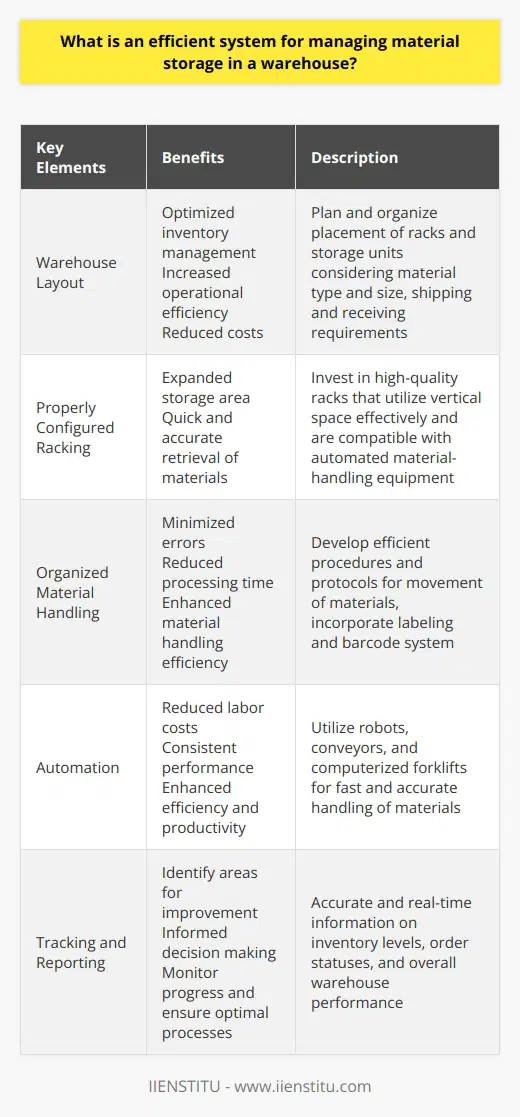
What safety measures should be taken to protect warehouse employees while storing materials?
The safety of warehouse employees within a warehouse setting is of utmost importance. Therefore, employers and employees must take all possible precautions to ensure a safe and secure working environment. In this article, we will discuss some safety measures that should be taken to protect warehouse employees while storing materials.
First and foremost, employers should ensure that the building meets the highest safety and security standards. Warehouse workers should be trained to identify potential hazards, including faulty lighting, wet or slippery floors, improper maintenance of safety equipment, or unsecured wires or cords. All risks should be assessed and corrected immediately.
In addition, employers should supply warehouse workers with the appropriate safety equipment, such as gloves, protective eyewear, hearing protection, and steel-toed boots. These items will help reduce the risk of accidents while working in the warehouse.
To protect warehouse employees while storing materials, employers should also provide adequate training to their workers. Employees should be familiar with the types of materials they are handling and understand the proper methods for loading, unloading, and storing materials. They should also understand specific regulations to protect them, such as labeling hazardous materials, understanding dangerous materials identification systems, and properly disposing of any hazardous materials.
Warehouses should also have clear signs to alert warehouse workers of safety precautions while working in the warehouse. This may include fire escape routes, chemical safety symbols, and warning signs for hazardous materials. Furthermore, warehouses should invest in lighting to allow workers to see clearly and avoid safety hazards.
Finally, employers should set up an effective system for reporting incidents in the warehouse. This may involve having a designated person responsible for collecting incident reports, investigating accidents/incidents, and reporting findings to management. This system will allow employers to identify potential problems and take corrective action to protect warehouse employees while storing materials.
In conclusion, employers need to take all reasonable steps to ensure the safety of warehouse employees while within the warehouse. By following the safety measures outlined in this article, employers can provide employees with work in a safe and secure environment.
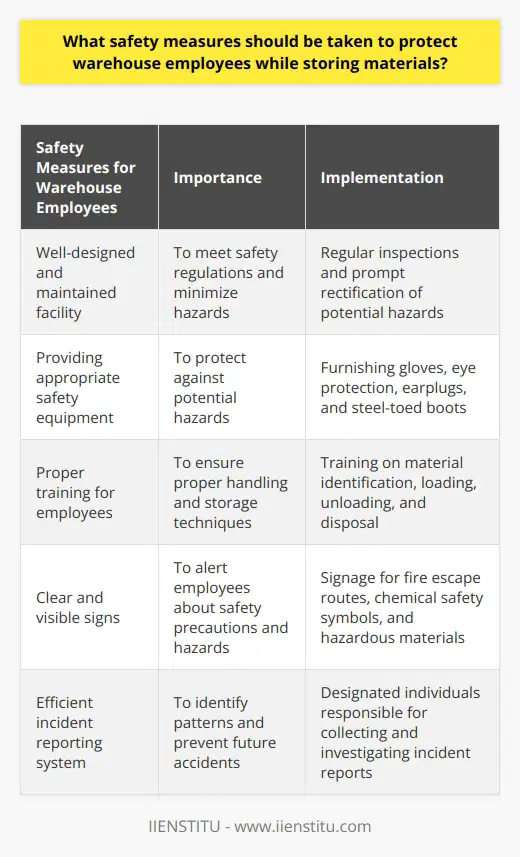
How can inventory control be improved to maximize the efficacy of material storage in a large warehouse facility?
Efficient inventory control is essential for maximizing the efficacy of material stored in a large warehouse facility. When goods are not accurately tracked and managed, there is the potential for loss and waste, and it cannot be easy to satisfy customer orders. Therefore, several measures must be taken to improve inventory control to facilitate a more efficient storage model and increase operational efficiencies.
Most warehouses have adopted barcode technology to track goods and products entering and exiting the facility. Barcodes record the movement and location of materials and associated cost-and-profit calculations. In addition, barcode systems can be used to improve inventory accuracy, increase the visibility of goods, and optimize warehouse layout and storage capabilities.
In-warehouse inventory management systems are also helpful for monitoring and controlling materials. This technology allows for real-time tracking of goods, enables accurate forecasting and reporting, and increases the accuracy of delivery and pick-up times. In addition, advanced tracking technologies, such as radio frequency identification (RFID) tags, can provide automated tracking of orders through the warehouse and make real-time inventory updates possible.
Warehouses are often assigned areas where items can be stored, typically based on category and size. To optimize storage capacity and facilitate fast processing and picking, it is essential to organize the warehouse according to standard operating procedures and stock rotation rules. For example, high-movement items should be placed close to the delivery and collection area. In contrast, non-high-movement items should be placed in safe, accessible locations.
The warehouse team must stay attuned to inventory levels and stock trends to maximize the efficacy of material stored in a large warehouse facility. Regular checking and inventory adjustment are recommended, and discrepancies should be cleared immediately. A robust inventory control system should also be in place, with a clear-cut plan for establishing new stock and monitoring inventory levels. Finally, encouraging employee collaboration, training, and communication can ensure that all productivity goals are met and that warehouse operations remain safe and efficient.
In conclusion, proper inventory control is essential for maintaining a well-managed and efficient storage model in a large warehouse facility. A warehouse can maximize its storage efficacy by implementing advanced technologies, following standard operating procedures, monitoring inventory trends, and providing adequate training.

What is the function of storage in warehouse?
Function of Storage in Warehouses
Purpose of Storage Space
A warehouse's primary function is to provide a centralized storage space designed for the safekeeping of goods and commodities. The strategic placement of warehouses allows businesses to efficiently manage the flow of materials through a supply chain. By consolidating products in one location, transportation costs are reduced, and the distribution process is made more efficient.
Inventory Management
Warehouses play an integral role in inventory management by allowing businesses to track the quantity and condition of their stored products. Through effective inventory control, enterprises can minimize stock obsolescence and achieve better resource allocation. This also supports reducing carrying costs while optimizing order fulfillment rates by ensuring goods are readily available for distribution.
Protection of Goods
The protection of goods is essential in a warehouse, where materials are dispatched or stored until required by the consumer. Warehouses safeguard products from environmental hazards such as rain, sunlight, and dust, ensuring their preservation and maintaining their quality. By implementing security measures and procedures, warehouses also prevent the theft or damage of goods.
Stock Consolidation
Warehouses offer the ability to consolidate goods coming from multiple sources, enhancing supply chain efficiency. By storing items under one roof, transportation costs between the supplier and the retailer or consumer are minimized. Warehouses can further expedite shipment processes through bulk breaking and cross-docking, providing a more cost-effective approach to materials handling.
Coordination of Supply and Demand
By serving as buffer points between manufacturers and consumers, warehouses help to bridge supply-demand gaps. This is critical in managing seasonal fluctuations, as businesses may store excess goods produced during off-peak seasons for later release during increased demand periods.
Value-Added Services
In addition to their primary storage function, warehouses often provide value-added services, such as packaging, labeling, and order assembly, which further enhance supply chain efficiency. These services allow businesses to focus on their core operations, resulting in more streamlined processes and improved customer satisfaction.
In conclusion, the function of storage in warehouses is multifaceted, ranging from providing a centralized location for inventory management and protection to adding value through supplementary services. Warehouses play a vital role in enhancing supply chain efficiency, reducing overall operational costs, and meeting the ever-changing demands of both businesses and consumers.
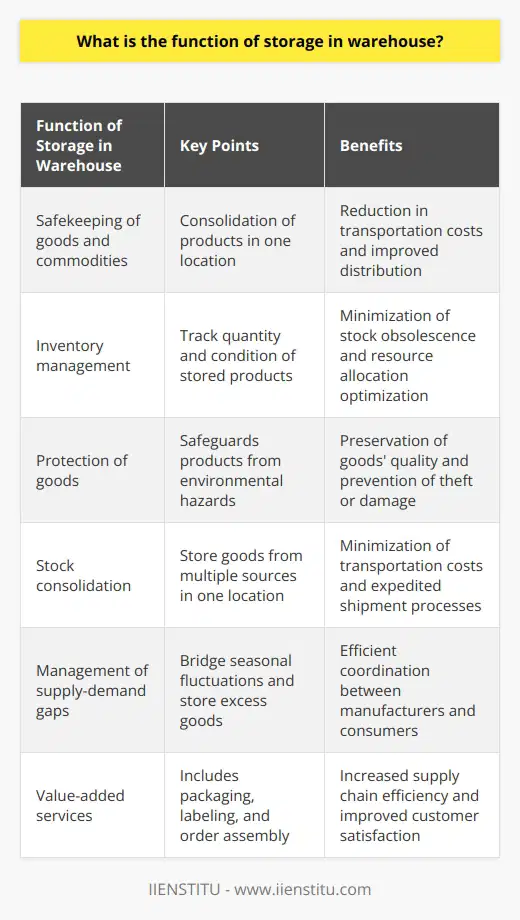
What are the 4 basic functions of a warehouse?
Key Function: Receiving Materials
One of the four basic functions of a warehouse is receiving materials or merchandise. It involves the careful checking of incoming goods for quality, quantity, and correctness against the purchase orders. This function is essential for ensuring accurate inventory management and effective supply chain management.
Efficient Storage of Goods
Another primary function of a warehouse is the storage of goods in an organized and systematic manner. This involves the strategic placement of goods for easy access and retrieval, which optimizes space utilization and reduces handling costs. Efficient storage ensures that goods remain in good condition, ready for distribution when needed.
Order Picking and Packaging
The third basic function of a warehouse is the order picking and packaging process. This involves the identification, retrieval, and packing of goods according to customer orders, as well as preparing the goods for shipment. This step is crucial for ensuring customer satisfaction by delivering the correct products in a timely manner and minimizing the chances of damage during transit.
Dispatching and Shipping
The final fundamental function of a warehouse is to dispatch and ship the packed goods to their respective destinations. This includes the loading of goods onto trucks, ships, or other transportation methods and providing the required documentation, such as shipping labels or invoices. This function is essential for delivering goods to customers promptly, maintaining a reliable distribution network, and facilitating smooth and efficient supply chain operations.
In conclusion, the four basic functions of a warehouse are receiving materials, storing goods, picking and packaging orders, and dispatching and shipping goods. These functions are critical for ensuring that inventory management, supply chain management, and overall customer satisfaction are achieved effectively and efficiently.
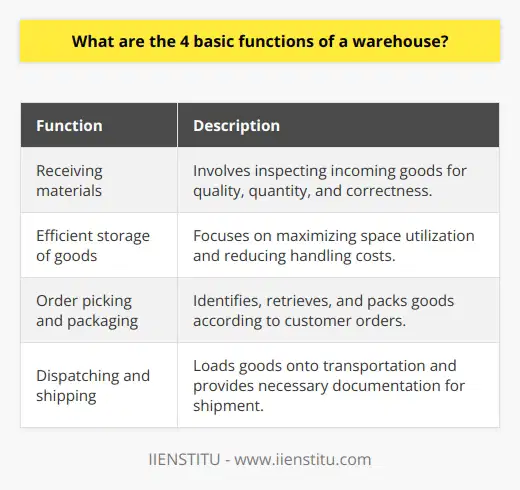
What is the importance of storage equipment in warehouse?
Effective Inventory Management
Storage equipment plays a crucial role in the efficient operation of a warehouse by enabling effective inventory management. It allows for the systematic organization of goods, which enhances the accessibility of items and helps in maintaining an accurate record of the stock levels. Properly organized storage equipment ensures that there is minimal to no loss of items due to misplacement or damage.
Optimization of Space Utilization
Warehouses often face challenges related to space constraints, making it crucial to have suitable storage equipment that optimizes the available area. By using innovative storage solutions like pallet racking, vertical storage systems or mezzanine flooring, businesses can store more inventory within limited spaces. Maximizing storage density also leads to decreased warehouse costs and improved overall efficiency.
Improved Safety and Security
The use of appropriate storage equipment ensures that the items in the warehouse are securely stored and less susceptible to accidents or theft. Well-designed storage structures provide stability, reduce the risk of product damage and ensure the safety of employees working within the facility. Secure storage equipment also prevents unauthorized access to valuable inventory, protecting it from potential theft or pilferage.
Enhanced Productivity and Time Efficiency
Proper storage equipment installation contributes significantly to enhancing the productivity of warehouse operations. Items become more easily identifiable and accessible, speeding up the process of selecting, picking and dispatching items. Moreover, an organized storage system reduces the time taken to conduct inventory checks, replenish stock or clean the warehouse, resulting in improved overall efficiency.
Environmental Sustainability
By implementing efficient storage equipment, warehouses can also contribute to environmental sustainability. Optimizing space utilization helps to reduce the need for additional facilities, thereby minimizing the business's environmental footprint. Furthermore, modern storage solutions utilize materials and designs that promote energy efficiency, such as natural ventilation or low-energy lighting fixtures.
In conclusion, storage equipment is an essential aspect of warehouse management that can significantly impact a business's productivity, cost-efficiency, and environmental footprint. By investing in suitable storage solutions, companies can ensure their warehouses operate at optimal levels, benefiting both the organization and the environment.
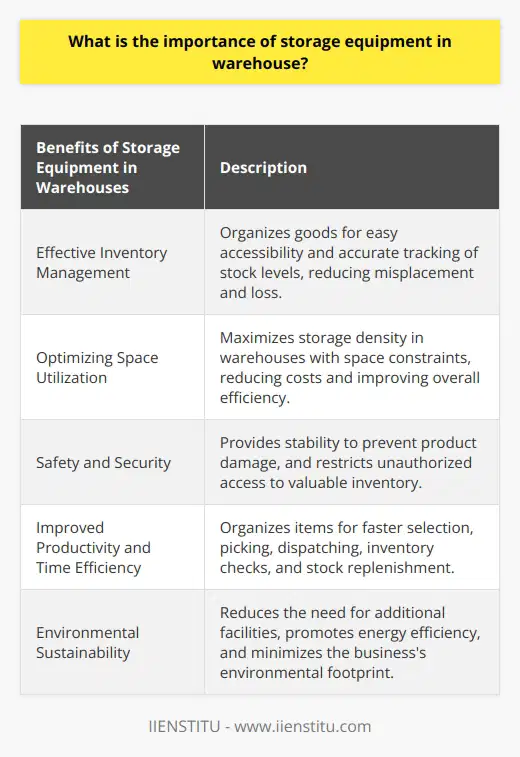
What is the storage function of a warehouse?
Storage Function: A Primary Objective
A warehouse serves as a crucial component in the supply chain by providing a designated space for the storage of goods and products. The main function of a warehouse is to serve as a storage facility that enables companies to stockpile inventory, ensuring that sufficient quantities are readily available for future use. This ultimately contributes to a smooth production process and timely delivery to customers.
Inventory Management: Efficiency and Optimization
A critical aspect of the storage function is effective inventory management, which involves the proper arrangement, organization, and tracking of products within the warehouse to mitigate possible challenges and minimize costs. By utilizing various inventory management systems, including barcode systems, radio-frequency identification (RFID) technology, and warehouse management software, warehouse operations can maintain accuracy and avoid the risk of stock-outs or overstock scenarios.
Goods Protection: Quality and Security
Another essential element of the storage function involves safeguarding the stored goods from external factors that may damage or degrade their quality. This includes climate control for perishable items, protection from pests, dust, and moisture, and the implementation of racking systems that ensure optimal circulation and accessibility. Moreover, the warehouse must provide a secure environment to prevent theft, fire, and other hazards. Restricting unauthorized access, installing proper surveillance systems, and employing trained security personnel are some measures taken to ensure a safe and secure storage space for the inventory.
Facilitating Operations: Receiving, Storing, and Shipping
In addition to providing storage, warehouses also facilitate various operative processes such as receiving incoming shipments, storing them according to established protocols, and shipping them when requested by customers. These tasks necessitate a high level of efficiency and organization to prevent delays, errors, or damage that could disrupt the supply chain. Adequate staffing, clear communication processes, and well-defined operational procedures are paramount for the successful execution of these storage-related functions.
In conclusion, the storage function of a warehouse plays a vital role in maintaining a seamless and efficient supply chain. By providing an organized space for inventory management, goods protection, and facilitating operations, warehouses ensure the availability, quality, and timely delivery of products to customers.
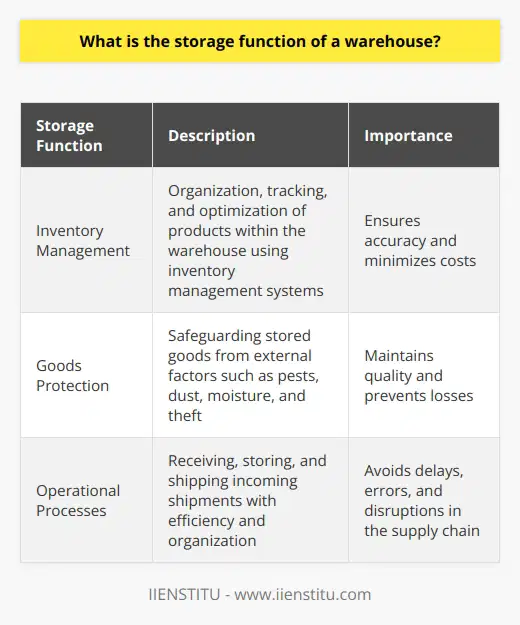
What are the four main functions of a warehouse?
**Warehouse Functions: Storage and Consolidation**
The primary function of a warehouse is providing storage for various goods, raw materials, and finished products, allowing businesses to maintain sufficient inventory levels. Warehouses enable companies to store their products safely and systematically until they are needed for distribution or production.
**Inventory Management**
Another crucial function of a warehouse is managing inventory levels. A well-organized warehouse is crucial for tracking, managing, and controlling the flow of goods. This capability ensures that the right amount and type of products are available when needed, averting stockouts or overstocking. Effective inventory management contributes to reducing business costs and improving customer satisfaction.
**Value-Adding Services**
Warehouses can also perform several value-adding services that enhance the worth of stored goods or prepare the products for sale. These services may include packaging, labeling, and kitting – the process of bundling products together to create a single unit. Providing such value-added services streamlines the supply chain, reduces costs, and ultimately benefits the end customer.
**Logistics Support**
Lastly, warehouses play a significant role in providing logistics support, which includes goods handling, transportation, and order fulfillment. Warehouses are strategically located near transportation hubs to decrease transportation costs and time, thus improving the efficiency and speed of product delivery. Furthermore, advanced warehouse management systems facilitate seamless order fulfillment and minimize errors. By providing an organized, efficient, and trustworthy logistics infrastructure, warehouses make supply chains more resilient and responsive to market demands.

What are the three main types of storage in a warehouse?
Types of Storage in a Warehouse
Pallet Racking System
One of the main types of storage in a warehouse is the pallet racking system, which provides efficient use of space and easy access to stored items. This type of storage comprises vertical frames and horizontal beams, where palletized goods are placed. The pallet racking system can be customized to suit specific warehouse requirements and can accommodate various sizes and weights of items.
Shelving Systems
Another crucial type of warehouse storage is shelving systems that are used for storing smaller items or products. Shelving systems are lightweight and easy to install, making them suitable for both temporary and permanent storage solutions in a warehouse. They are available in various materials such as metal, plastic, or wood, and can be fitted with bins, drawers, or other organizational tools to allow for efficient and accessible storage of smaller items.
Automated Storage and Retrieval System (AS/RS)
The third primary type of storage in a warehouse is the automated storage and retrieval system (AS/RS), which is a technologically advanced method of storing and retrieving goods. AS/RS utilizes robotic equipment, conveyor belts, and computer-controlled systems to manage and move warehouse items with minimal human intervention. This type of storage solution offers increased efficiency, accuracy, and safety while reducing labor costs and human error.
In conclusion, the main types of storage utilized in warehouses are pallet racking systems, shelving systems, and automated storage and retrieval systems. These systems cater to specific needs and requirements to optimize storage space and efficiency within warehouse environments.


